
Chapter 5: Craters (4/6)
|
[140] |
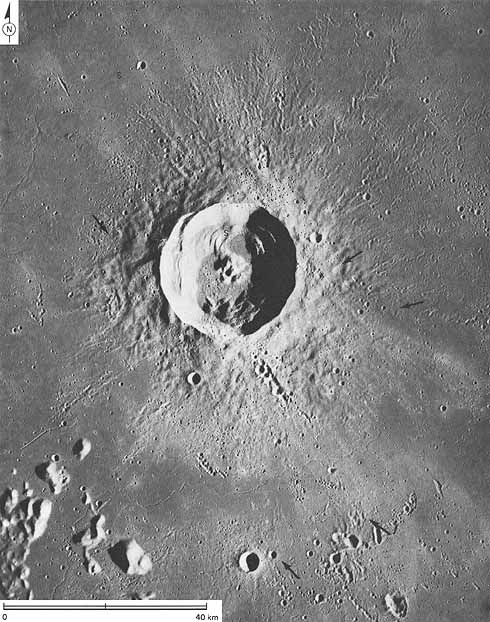 |
[141] FIGURE 138 [above].-This similar view of Euler, taken with the Apollo 17 mapping camera, is included because it shows even more clearly the relationship between the ejecta from Euler and the surrounding mare lavas. The youngest lava flows in the Imbrium basin (Schaber, 1973) have overlapped and embayed the Euler ejecta from the north, west, and south-especially at places marked by arrows. The long sinuous rifle south of Euler is associated with the late stage lava flooding. The clusters of large secondary craters (S) are from Copernicus, 400 km to the southwest. In the southeast part of the picture some of these secondary craters and their associated ray deposits overlie the mare lavas. The following sequence of events therefore took place: (1) the Euler impact, (2) flooding by lava, and (3) the impact of material ejected from Copernicus.-G.G.S.
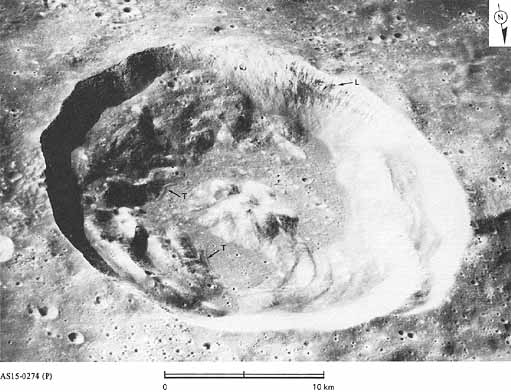
FIGURE 139 [above].-In this oblique view of Euler some details are shown that are not visible in figures 137 and 138. Note, for example, the ledges (L) of bedrock cropping out along the south wall and the low terraces (~ at the points of contact between the slump masses and the floor. They may be aprons of debris or "bathtub rings" of lava like those shown earlier in figure 69. This oblique viewing angle also enhances the polygonal outline of Euler's rim crest and the size and ruggedness of the huge masses that have slumped from the walls.-G.G.S.
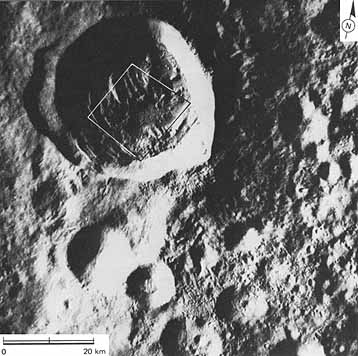 |
[142] FIGURE 140 [left].-This crater on the lunar far side is similar in age and size to the near- side crater Euler (figs. 137 to 139). It is located midway between the craters Becvar and Langemak. Thirty-six km in diameter, it was informally called the "Bright One" by the Apollo 14 astronauts because of its bright ejecta and ray pattern. The bright halo that surrounds the crater is about 150 km in diameter. Its brightness is not evident in this view because the picture was taken when the Sun angle was low. The radial pattern of dunelike ejecta around the crater is most apparent where the Sun's rays are perpendicular to the direction of ejecta flow, as in the lower part of the picture. The hummocky or bumpy floor of the crater is caused largely by material that has slumped from the walls. Stuart A. Roosa, the Apollo 14 CMP, used a handheld camera with an 80-mm lens for this photograph. Later, using a 500-mm lens, he photographed in much more detail that part of the floor of the crater outlined in this photograph and shown in figure 141.-M.C.M.
|
|
| |
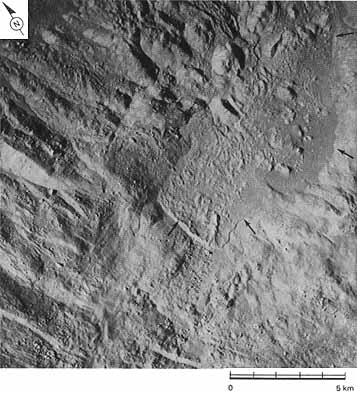 |
FIGURE 141 [left].-When photographed with the 500-mm lens, the abundance of blocks (bright spots with shadows extending to the right) attests to the freshness of the materials on the floor of the "Bright One." Material that has flowed and in some instances formed smooth-surfaced "pools" is evident in much of the area. Arrows mark the edge of a major flow distinguished by its surface texture, color (in the original negative), location in a topographic low, and clearly defined border. Note that the abundance of boulders in the flow is much less than in nearby areas, presumably because the flow has buried most of the boulders in its path. Scientists generally agree that material has flowed here, and on the floors and flanks of many other craters, but the nature of the material that has flowed is a matter of debate.-M.C.M.
|
|
[143] FIGURE 142 [right].-This oblique view of the crater Timocharis in southeastern Mare Imbrium illustrates how the original diameter of a crater is enlarged by slumping of its walls. Its present diameter is about 35 km. The sparsity of small superposed craters on the walls of Timocharis-in contrast to their density on its floor and rim-is caused by the erosive effect of downslope movement of material on the steep walls. Timocharis, like many other young impact craters of similar size, possesses a well-defined central peak complex. Such structures are believed to result from elastic rebound of the bedrock immediately after the impacting event. However, the central peak of Timocharis apparently has been substantially modified by a large superimposed crater.-G.G.S.
|
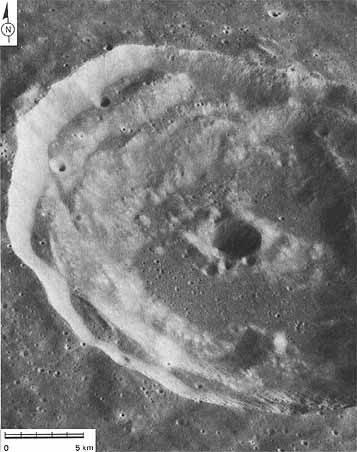 |
|
| |
|
FIGURE 143 [right].-High Sun views such as this often show fascinating dark and bright patterns that would be overwhelmed by highlights or shadows if the Sun were lower in the sky. This view of the 17-km-wide crater Jansen B shows numerous bright avalanche deposits on the steep crater walls, apparently originating at outcrop ledges near the top of the wall. Most avalanches stop in a moat at the base of the wall, but a few in the foreground extend out onto the irregular, inward- sloping floor. The floor is a jumble of slump blocks. Avalanching appears to be a major means of erosion on steep lunar slopes.-K.A.H. |
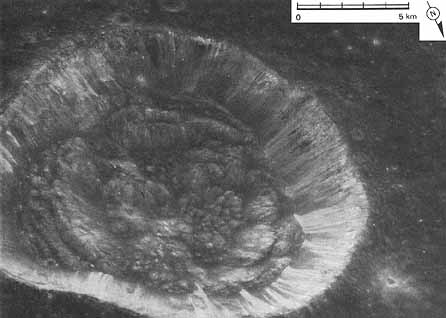 |
|
[144] FIGURE 144 [right].-This is a near vertical view of the crater Dawes, 18 km in diameter. Morphologically it is typical of many lunar craters in the 15- to 20-km size range. It lacks terraced walls and distinct central peaks but has an extremely rough floor. Small terracelike structures on the crater floor (upper left, lower right) occur where the wall is bowed outward and probably represent slump deposits where portions of the crater wall have collapsed into the crater. Local stratigraphy is revealed in the walls of the crater, and material of different albedo is seen streaming down into the crater from various levels. The dark layer clearly visible in the upper part of the crater wall represents the thin mare deposits in this part of northern Mare Tranquillitatis. The lighter gray material below it is a combination of underlying submare material and talus from units higher on the crater wall. The highest unit (white and gray) probably represents the ejecta blanket and may consist primarily of lighter lunar crustal material excavated from beneath the mare.-J.W.H. |
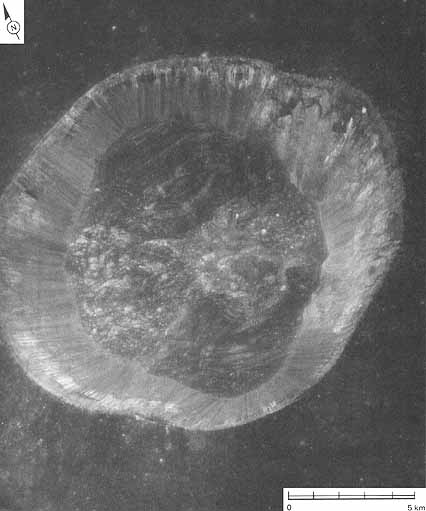 |
|
[145] |
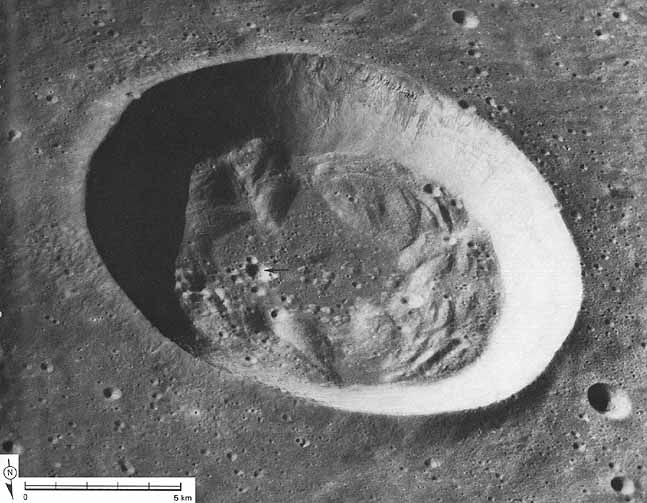 |
FIGURE 145 [above].-Outcrops of layered rock are strikingly evident in the upper part of the far wall of the crater Bessel (17- km diameter) in south-central Mare Serenitatis. The outcrop is most evident where it forms shadows; however, the dark debris that streams downslope from the layered rock is visible even on parts of the crater wall where the Sun has washed out all details of relief. The outcrop is at a uniform distance below the crater rim, indicating that the strata are horizontal. Thus, Bessel furnishes convincing evidence that mare surfaces are underlain by dark layered rock. The dark rock is now known to be basalt that accumulated as successive flows or layers of lava. Bessel is youthful enough that boulders are abundant on its rim and floor. An anomalously high number of boulders is visible in and around the 750-m diameter crater (arrow) on the floor.-M.C.M.
|
[146] |
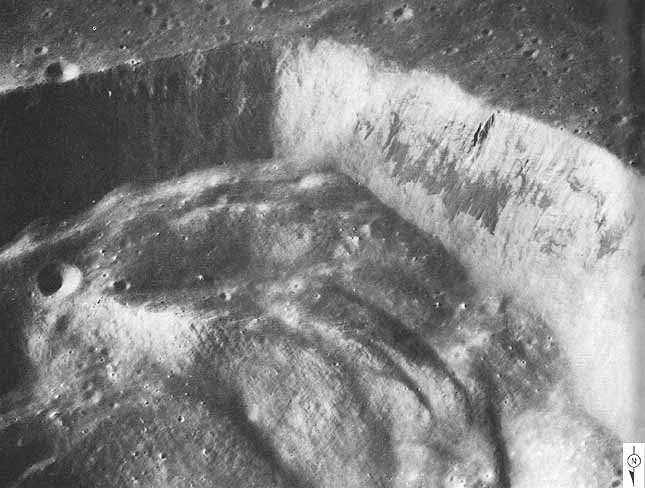 |
FIGURE 146 [above].-The Apollo 17 panoramic camera provided this high-resolution, enlarged view of the south wall of Pytheas. Pytheas is about the same size as Bessel (fig. 145), but is located in south-central Mare Imbrium almost 1100 km west of the latter. The outcrops in the walls of the two craters are remarkably similar. These and the many other craters in mare areas that contain outcrops of dark horizontally layered rock demonstrate the moonwide uniformity of conditions in the upper part of the mare basins.-M.C.M.
|
[147] FIGURE 147 [right].- This oblique view looks south over the 26-km-diameter crater Proclus in the highlands at the western edge of Mare Crisium. Proclus is a young rayed crater that is distinctive because of the marked asymmetry of its ray system-a characteristic visible even in Earth-based telescopic views. The excluded zone is along the southwest edge (top of photograph) but is visible in this moderate Sun photo only as a slight albedo change. Laboratory experiments suggest that a low trajectory angle might account for the asymmetry. A number of large blocks can be seen at the edge of the crater rim. The exceptionally large block (arrow) is about 200 m wide and, judging from the length of the shadow it casts, nearly as high. As in several other craters shown in this chapter, a darker layer is present in the upper part of the crater wall.-J.W.H.
|
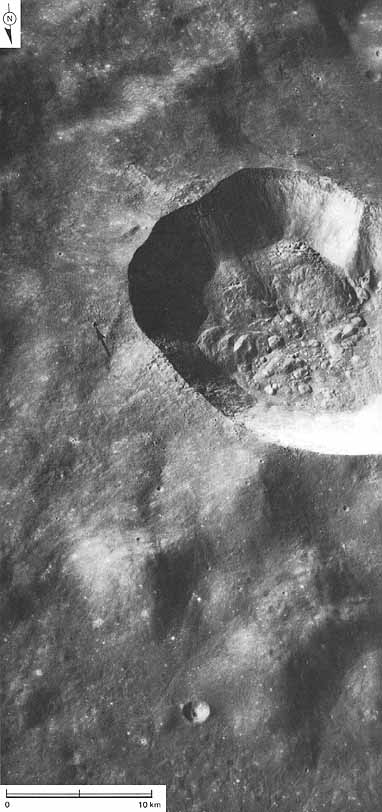 |
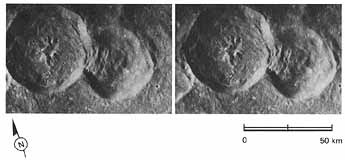 |
|
[148] FIGURE 148 [above].-This pair of overlapping medium-sized craters illustrates some of the criteria used to determine relative ages. Material ejected from the larger polygonal crater on the left partially fills the smaller crater on the right; thus, the crater on the left is younger. Furthermore, the wall of the large crater is complete, whereas the west wall of the smaller crater is absent, obviously having been destroyed by the larger crater. Even if the two craters did not overlap, the sharp rim, terraced walls, and prominent central peak of the larger crater clearly identify it as the younger of the two. The frames used in the stereogram were selected to show exaggerated relief, a technique very helpful to photointerpreters in determining shapes and relative elevations of surface features. The two craters are located in the rugged terrain of the far-side highlands approximately 250 km north of the prominent crater Tsiolkovsky. The photograph below is an oblique view of the same pair of craters. It is included, not because it is a more dramatic view, but because it shows from another perspective that one crater clearly is superposed on the other. -M.C.M.
|
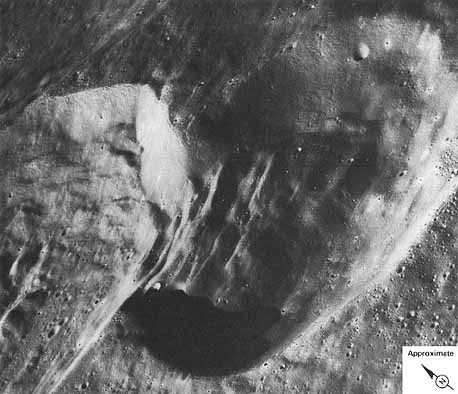 |
|
[149] |
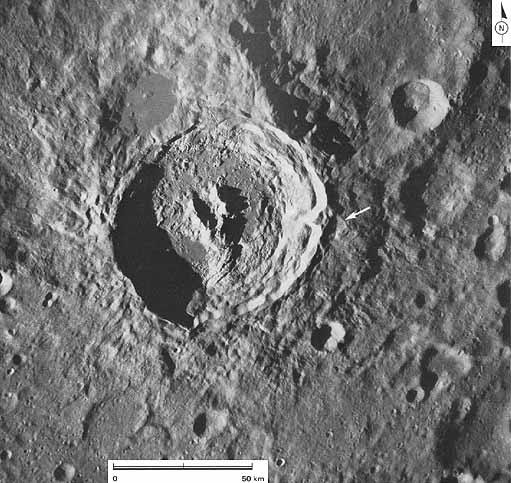 |
FIGURE 149 [above].-This vertical view of the crater King on the lunar far side was taken with the Apollo 16 Hasselblad camera. King, approximately 75 km in diameter and 4 km deep, is one of the most interesting features on the far side. It is a superb example of a youthful, large crater. It attracted much attention and was the object of numerous scientific studies (e.g., El-Baz, 1972b; Young, Brennan, and Wolfe, 1972). King is the freshest crater on the far side in its size range. Among its many interesting features are (1) a unique lobster-claw-like central peak, (2) a flat poollike area of dark material on the north rim believed to have once been molten, (3) a very-well-developed field of fine ejecta extending outward for approximately two crater diameters, and (4) a massive landslide on the southeast rim (see arrow). In this view the southern part of the central peak has a distinctly ropey appearance and is segmented parallel to the terraces of the adjacent crater wall. The low Sun illumination enhances the fine texture of King's ejecta. Northeast of King the ejecta mantles an old large crater and in the southwest corner of the picture it mantles a relatively smooth terra unit. The slightly raised plateau on which the crater is situated may be part of the ring of an old basin.-F.E.-B.
|
[150]
|
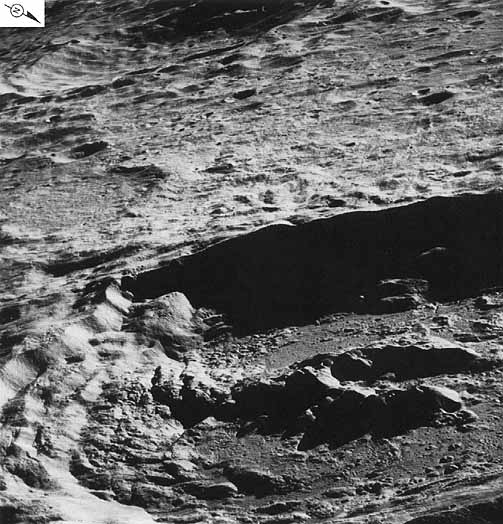 |
FIGURE 150 [above].-The similarity in appearance of the southern part of the central peak and the slump terraces on the southern wall of the crater is emphasized in this oblique view of the crater King. The parallelism of the two arms of the central peak and the southern segment of the peak suggests that the unique shape of the structure is caused by a preexisting tabular body that was excavated during the formation of the crater (El-Baz, 1972b). Numerous comical structures with summit pits are present on the crater floor in the lower right part of the photograph.-F.E.-B.
|
[151]
|
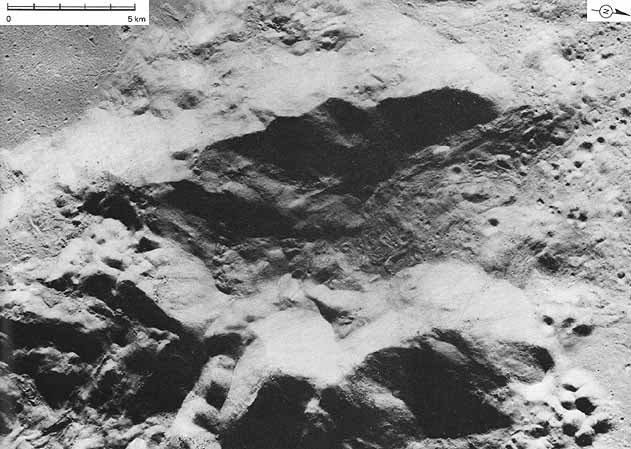 |
FIGURE 151 [above].-The northern part of the central peak complex of the crater King is shown in this enlarged view. The massifs forming the arms of the central peak trend approximately north-south. They are crossed by linear valleys that are the surface expressions of faults. The blocks that litter the peaks attest to the freshness of the structure and, therefore, of the crater King itself. The floor material surrounding the massifs is very hummocky and shows many flow patterns. Arcuate flow boundaries, flow channels, and cooling cracks indicate that this material was once molten, perhaps because of shock melting at the time of the crater formation.-F.E.-B.
| Next |